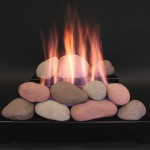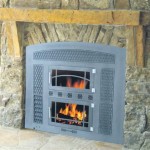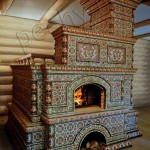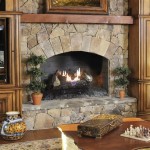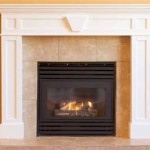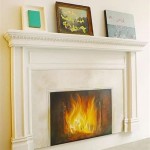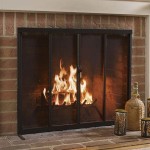Brick Fireplace With Stone Hearth: A Comprehensive Guide
A brick fireplace with a stone hearth represents a classic and enduring architectural feature in homes. This combination offers a blend of aesthetic appeal, functional warmth, and timeless design. Understanding the nuances of this fireplace design, from material selection to construction considerations, is crucial for homeowners seeking to incorporate this element into their living spaces.
The brick fireplace, known for its heat retention and rustic charm, complements the natural beauty and durability of a stone hearth. This pairing often becomes the focal point of a room, creating a cozy and inviting atmosphere. The selection of brick and stone, along with the overall design, significantly impacts the aesthetic and functional aspects of the fireplace. This article provides a comprehensive overview of brick fireplaces with stone hearths, addressing key considerations for planning, construction, and maintenance.
Material Selection: Brick and Stone Varieties
The selection of both brick and stone significantly influences the overall aesthetic and performance of the fireplace. Brick comes in various types, each with unique characteristics. Common brick, also known as building brick, is a standard choice, offering a balance of affordability and durability. Face brick, designed for exposed surfaces, provides a wider range of colors, textures, and sizes, enhancing the visual appeal of the fireplace surround. Firebrick, specifically formulated to withstand high temperatures, is essential for lining the firebox, protecting the surrounding brickwork from heat damage.
Stone options for the hearth are equally diverse. Natural stone, such as granite, slate, marble, and limestone, offers unique patterns and textures. Each stone type possesses different levels of heat resistance, porosity, and durability. Granite, for instance, is highly durable and heat-resistant, making it a popular choice for hearths. Slate provides a naturally textured surface with a range of colors, while marble offers a more luxurious and refined aesthetic. Limestone, with its softer texture and warm tones, provides a classic and timeless appeal.
Manufactured stone, also known as cultured stone, offers a cost-effective alternative to natural stone. It replicates the look and feel of natural stone while providing greater consistency in color and texture. Manufactured stone is often lighter than natural stone, reducing the structural demands on the fireplace foundation. Furthermore, it is typically easier to install and requires less maintenance than natural stone.
Consideration should be given to the color and texture of both the brick and stone to ensure they complement each other and the overall design of the room. A harmonious blend of colors and textures creates a visually appealing and cohesive fireplace design. Samples of both brick and stone should be viewed under different lighting conditions to assess their appearance and ensure they meet the desired aesthetic preferences.
Design Considerations: Aesthetics and Functionality
The design of a brick fireplace with a stone hearth involves a careful balance of aesthetics and functionality. The fireplace surround, the area surrounding the firebox, provides an opportunity to express architectural style and personal preferences. Options range from simple, minimalist designs to elaborate, ornate structures. The size and shape of the surround should be proportional to the size of the room and the scale of the fireplace.
The hearth, the horizontal surface extending outward from the firebox, serves both a functional and aesthetic purpose. It provides a safe barrier between the firebox and the surrounding floor, preventing sparks and embers from igniting flammable materials. The size of the hearth is dictated by building codes and safety regulations, ensuring adequate protection from the fire. A larger hearth can also serve as a seating area or a display surface for decorative items.
The firebox, the chamber where the fire burns, must be constructed of firebrick to withstand the extreme temperatures. The size and shape of the firebox influence the efficiency of the fireplace, affecting the amount of heat produced and the rate of fuel consumption. A well-designed firebox promotes efficient combustion and reduces the amount of smoke released into the room.
The chimney, responsible for venting smoke and gases from the firebox, must be properly sized and constructed to ensure adequate draft. A chimney that is too small or poorly constructed can result in smoke backdrafting into the room, creating a hazardous situation. Building codes specify the minimum height and diameter of the chimney based on the size of the firebox and the surrounding structures.
Integrating the fireplace into the overall design of the room is essential for creating a cohesive and harmonious space. The style of the fireplace should complement the existing architectural features and décor. Consider the placement of the fireplace in relation to furniture and traffic patterns, ensuring it enhances the functionality and flow of the room. A well-designed fireplace becomes a natural focal point, adding warmth and character to the living space.
Construction Process: From Foundation to Finish
The construction of a brick fireplace with a stone hearth requires meticulous planning and execution, adhering to building codes and safety regulations. The foundation is the critical starting point, providing a stable base for the entire structure. The foundation must be strong enough to support the weight of the fireplace, chimney, and any surrounding masonry. A concrete slab foundation is typically used, reinforced with steel rebar for added strength.
The firebox construction involves laying firebrick in a specific pattern, using refractory mortar to withstand high temperatures. The firebox should be properly insulated to prevent heat transfer to the surrounding brickwork. A smoke chamber, located above the firebox, collects smoke and guides it into the chimney. The smoke chamber should be smooth and tapered to promote efficient airflow.
The chimney construction requires careful attention to detail, ensuring proper draft and preventing smoke leakage. The chimney is typically constructed of brick or concrete blocks, lined with a clay flue liner. The flue liner protects the chimney from corrosive gases and creosote buildup. The chimney should extend above the roofline to prevent wind from interfering with the draft.
The installation of the stone hearth involves setting the stone slabs on a bed of mortar, ensuring they are level and securely attached to the foundation. The stone slabs should be properly sealed to protect them from staining and moisture damage. Grouting the joints between the stone slabs provides a watertight seal and enhances the aesthetic appeal of the hearth.
The final step involves finishing the fireplace surround, adding decorative elements, and ensuring all components are properly installed and functioning. The surround can be finished with brick, stone, or other materials, depending on the desired aesthetic. Inspecting the fireplace for any cracks or defects is crucial before using it. A professional fireplace installer can ensure the fireplace is constructed safely and efficiently, providing years of reliable performance.
Maintenance and Safety: Ensuring Longevity and Security
Regular maintenance is essential for ensuring the longevity and safe operation of a brick fireplace with a stone hearth. Creosote, a flammable byproduct of burning wood, can accumulate in the chimney, posing a significant fire hazard. Annual chimney inspections and cleaning by a qualified chimney sweep are crucial for removing creosote buildup and preventing chimney fires.
Inspecting the firebox regularly for cracks or damage is also important. Cracks in the firebrick can allow heat to escape and damage the surrounding brickwork. Repairing any cracks promptly prevents further damage and ensures the safe operation of the fireplace. Replacing damaged firebrick with new firebrick and refractory mortar restores the integrity of the firebox.
Properly storing and seasoning firewood is essential for efficient and safe burning. Seasoned firewood, which has been allowed to dry for at least six months, burns more efficiently and produces less smoke and creosote. Storing firewood in a dry, well-ventilated area prevents it from rotting and becoming infested with insects.
Using a fireplace screen or doors prevents sparks and embers from escaping the firebox, reducing the risk of fire. Fireplace screens and doors also help to contain smoke and prevent drafts. Ensure the screen or doors fit snugly against the fireplace opening to provide adequate protection.
Installing carbon monoxide detectors in the home is crucial for detecting the presence of carbon monoxide, a colorless and odorless gas that can be produced by incomplete combustion. Carbon monoxide can be deadly, so it is essential to have working carbon monoxide detectors installed near sleeping areas. Regularly test the detectors to ensure they are functioning properly. Following these maintenance and safety guidelines ensures the safe and efficient operation of a brick fireplace with a stone hearth, providing warmth and enjoyment for years to come.

Brick And Stone Combination Fireplace Redo

Brick Fireplace With Oak Mantle And Stone Hearth Red Fireplaces

Stone Fireplace Hearth Ideas Brick Decor Red Fireplaces

Fireplace Inspiration 10 Fireplaces That Showcase Natural Brick Or Stone Home Decor Makeover

Fixr Com Brick Vs Stone Fireplace Pros Cons Comparisons And Costs

How To Build A Concrete Fireplace Hearth Stone Red Brick Fireplaces Remodel

Some Stone Fireplace Surround Ideas You Ll Love Southwest Supply

Brick Fireplaces Stone Ulman Masonry

Stone Veneer Over A Brick Fireplace Updates The Look

N Stone Hearth Brick Inside Wood Mantel Log Burner Living Room Fireplace Oak Beam

